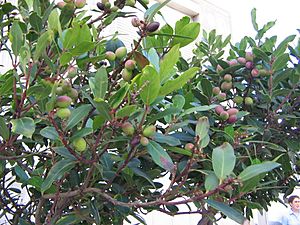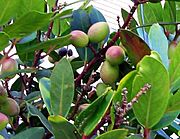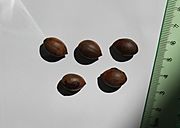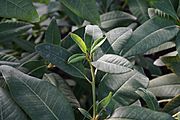Persea indica facts for kids
Quick facts for kids Persea indica |
|
|---|---|
 |
|
| Conservation status | |
| Scientific classification | |
| Genus: |
Persea
|
| Species: |
indica
|
Persea indica is a large, evergreen tree. It belongs to the laurel family, which is called Lauraceae. This tree is native to the Madeira and Canary Islands. These islands are found in the North Atlantic Ocean.
Persea indica grows in humid, high-up areas. It is part of the genus Persea, which also includes the avocado tree. Sadly, this tree is currently threatened because its natural home is disappearing. It has also been brought to some islands in the nearby Azores.
About the Persea Trees
Scientists have found old evidence that the Persea group of trees first appeared in West Africa. This was a very long time ago, during a period called the Paleocene. From Africa, these trees spread out to Asia, South America, Europe, and North America.
Over many millions of years, the climate changed. Africa, West Asia, and the Mediterranean region became much drier. Also, Europe experienced ice ages. These changes caused most Persea trees to die out in these areas. This is why we see them in their current locations today.
The Persea trees slowly disappeared from Africa as it became drier. Today, almost all Persea trees are gone from Africa. But Persea indica is special. It survived in the cool, misty cloud forests of the Canary Islands.
Ancient Discoveries
Scientists have found fossils of Persea indica in Turkey. These fossils were found in an area called Kızılcahamam. They are from a time called the early Pliocene age. This shows that Persea indica used to grow in Turkey many millions of years ago.
See also
 In Spanish: Viñátigo para niños
In Spanish: Viñátigo para niños
- List of animal and plant symbols of the Canary Islands





